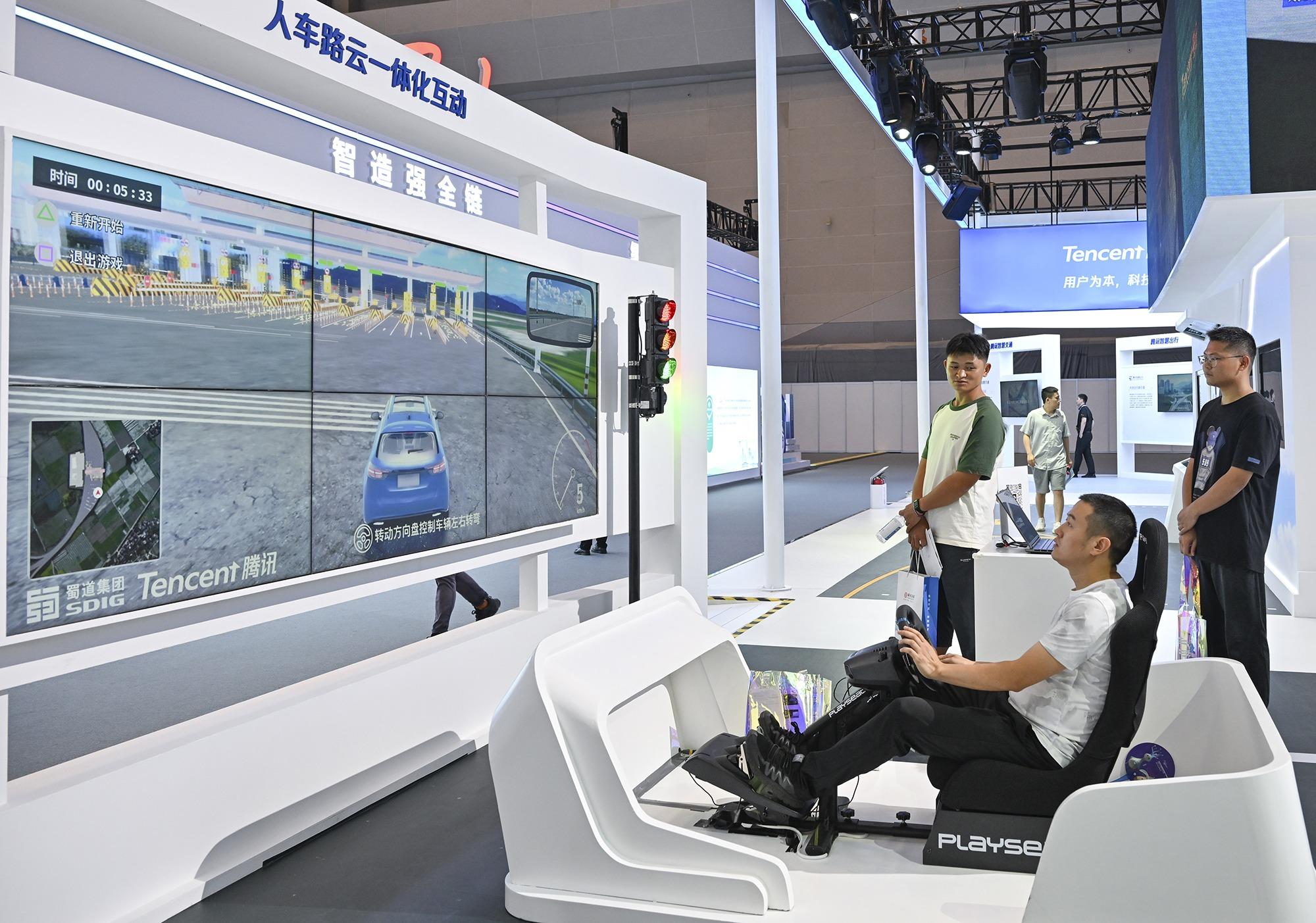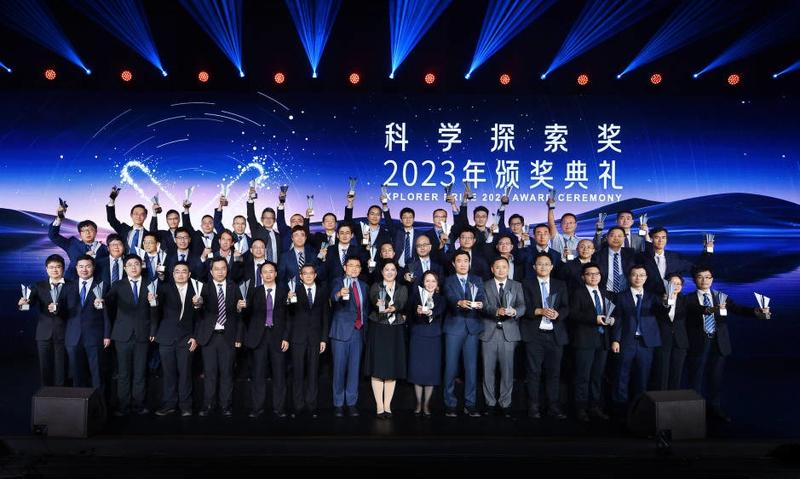Chinese R&D spending expected to surge further amid focus on tech breakthroughs and innovation-led growth
 Researchers from an automation equipment company in Nanjing, Jiangsu province, prepare for the radiation emission experiment in an electromagnetic compatibility lab on July 7, 2023. (PHOTO / XINHUA)
Researchers from an automation equipment company in Nanjing, Jiangsu province, prepare for the radiation emission experiment in an electromagnetic compatibility lab on July 7, 2023. (PHOTO / XINHUA)
China, including its major business enterprises, is investing big on research and development for breakthroughs in cutting-edge technologies, to not only make innovation integral to economic growth, but gain a global edge.
According to the National Bureau of Statistics (NBS), some 3.08 trillion yuan ($420.9 billion) has been allocated for R&D in the country in 2022, up 10.1 percent year-on-year, and much more is in the offing for the future.
The R&D expenditure of enterprises reached 2.39 trillion yuan in 2022, up 11 percent year-on-year, contributing 84 percent of the country’s R&D growth, up 4.6 percentage points from the previous year.
Deng Zigang, a researcher at Southwest Jiaotong University in Chengdu, capital of Sichuan province, epitomizes China’s recent thrust on R&D. Five years ago, Deng wanted to develop a vacuum-tube maglev. In the initial stages of executing his ambitious project, he targeted a 45-meter loop and a top speed of 50 kilometers per hour. But, some experts were skeptical. The experts, Deng recalled, said the eventual outcome of his research would be “a toy”, not a serious transportation option.
Such attitudes savaged Deng’s confidence, but he did not give up on his dream. Instead, he persisted despite not receiving much recognition for his efforts. Ultimately, his sustained focus on the frontier area paid off — he won the Xplorer Prize co-initiated by Ma Huateng, Tencent Chairman and CEO and founder of the Tencent Foundation, and a number of renowned scientists.
The prize, launched in 2019, encourages talented young scientists to concentrate on basic research and R&D of frontier technologies.
“It really meant a lot to me and our research team as we felt more empowered, more confident, and more motivated,” Deng said, adding that it is gratifying to see that his area of specialization has now become a key focus of research both in China and abroad.
Over the past five years, Deng and his team have developed a high-speed maglev experimental loop in China, making improvements to the project continuously. Theirs is the world’s first high-temperature superconductor vehicle test platform that can withstand speeds of up to 620 kilometers per hour, promising a new generation of transportation technology that could benefit not just China, but the entire world. It is an area where several countries and regions are striving for a breakthrough.
 A visitor experiences the driver-vehicle-road cloud integration program at the Tencent exhibition booth during the Smart China Expo 2023 in Chongqing on Sept 4, 2023. (PHOTO / XINHUA)
A visitor experiences the driver-vehicle-road cloud integration program at the Tencent exhibition booth during the Smart China Expo 2023 in Chongqing on Sept 4, 2023. (PHOTO / XINHUA)
According to the NBS, China will scale up its R&D budget by more than 7 percent annually during the 14th Five-Year Plan (2021-25) period. Consultancy McKinsey & Co said in a report that such a growth target will make China the world’s largest spender on R&D.
The NBS said China’s R&D expenditure accounted for 2.54 percent of GDP last year, which is 0.11 of a percentage point higher than the level in the previous year. Though the figure is close to the average of 2.67 percent for Organization for Economic Cooperation and Development economies, it gave China 13th place globally, far behind some developed economies like the United States, which tops the table.
“Although the R&D intensity of China has been continuously increasing, the country’s investment in basic research is insufficient, which directly leads to a relative lack of innovations based on complex, underlying supporting technologies and scientific research,” Liu Qiao, dean of the Guanghua School of Management of Peking University, said in a note.
Liu said China’s position index in the global value chain (GVC) in 2018 was 0.01, while that of the US was 0.29. This means, the US continues to be at the absolute upstream of the GVC and has strong control over core technologies and raw materials. This gives it the power to create constraints for other countries and economies downstream in the GVC.
“To change this situation, China must increase investment in basic R&D and promote Chinese industries to move upstream in the global value chain. Only when breakthroughs are achieved in basic research can we truly break developed countries’ vice-like grip on key technologies,” he said.
Wu Hequan, an academician at the Chinese Academy of Engineering, said basic R&D has a high degree of uncertainty and requires space for trial and error before success can be attained.
“But if everyone aims for success, there will be few opportunities for disruptive innovations,” Wu said. “Thus, it requires joint efforts from researchers, the government, and social forces like companies.”
To encourage such R&D and support full-time research professionals under the age of 45 working in China, Ma Huateng and a group of renowned scientists initiated the Xplorer Prize, for those working in fields like mathematics, physics, chemistry, new materials, astronomy, geoscience, advanced manufacturing, and other frontier technology areas.
Each prize winner receives 3 million yuan spread over five years — unprecedented in scale for scientific awards in China. Researchers and scientists who are awarded the prize are free to use the money in any way they deem fit.
 Awardees of the Xplorer Prize pose for a group photo during the 2023 Xplorer Prize Award Ceremony in Shenzhen in September. (PHOTO PROVIDED TO CHINA DAILY)
Awardees of the Xplorer Prize pose for a group photo during the 2023 Xplorer Prize Award Ceremony in Shenzhen in September. (PHOTO PROVIDED TO CHINA DAILY)
In late September, a cohort of 48 young scientists was awarded this year’s Xplorer Prize. One of them is geologist and planetary scientist Joseph Ryan Michalski, an associate professor at the University of Hong Kong and a US national, the first non-Chinese to win the prize for his studies on Mars. As of September, 248 young scientists had been awarded the prize. The research achievements of seven awardees have made it into the Top 10 of China’s annual scientific advances.
Zhou Huanping, a professor at Peking University and an Xplorer Prize winner, said she gathered more confidence to shift her R&D focus from “short-term and easy projects” to those with “higher uncertainties but greater significance”.
Xi Dan, senior vice-president of Tencent, said: “Tencent’s aim is to make the most of the flexible advantages of social funds, strive to become a useful supplement to nationally funded basic scientific research.
“We hope to offer scientists more confidence and determination to devote themselves to basic science, stimulate more zero-to-one innovations, and offer more impetus for scientific and technological innovation.”
Tencent, he said, is also aiming to explore innovative models of long-term stable support for basic science through social funds, which is also in line with the government’s encouragement for companies to play a bigger role in driving social progress and economic development.
Earlier this year, China’s top leadership said in Qiushi, the flagship magazine of the Communist Party of China Central Committee, that more efforts should be made to steadily increase financial investment in basic research, encourage enterprises to increase investment through various means such as tax incentives, and encourage them to establish scientific funds, donations, and other diversified investments.
Currently, several major tech companies in China are striving to invest more in R&D. The NBS said in September that many companies are expanding their investments in important sectors, laying a solid foundation for breakthroughs in core technologies across key fields.
Huawei Technologies Co, Baidu Inc, and iFlytek are among the companies devoting funds to R&D that could help not only themselves but society at large, by creating social goods.
For instance, in 2018, Alibaba Group initiated the Damo Academy Youth Orange Award to encourage young researchers under 35 to pursue innovations in fields like theoretical mathematics, quantum physics, medicine, and semiconductors. It carries prize money of 1 million yuan each. Some 53 young researchers have received the award so far.
Peng Wensheng, chief economist and research head at China International Capital Corp, said in an earlier interview with China Daily: “As demographic dividends gradually decrease, China’s economy will rely more on technological innovations in the future. To achieve such technological progress, continuous R&D investment is key. China’s R&D investment must be increased substantially in the coming decades to overcome what we call the late-mover disadvantage.”


